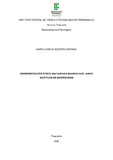| dc.description.abstract | This study aimed to analyze the ethnic-racial representation in the images present in
nursing textbooks used in Brazil, focusing on the diversity of skin tones. The
methodology employed was a descriptive and documentary study, which examined
five textbooks widely used in nursing education. A total of 3,407 images of human
beings were analyzed through a systematic classification of skin tone, identifying the
number of images representing individuals with light and dark skin. The results
revealed that only 21.19% of the images depicted people with dark skin tones,
indicating a low representation of this population in educational materials. The
textbook that showed the highest proportion of images with dark skin tones was
Tratado de Enfermagem Médico-Cirúrgico ("Textbook of Medical-Surgical Nursing"),
with approximately 29%. This discrepancy indicates a predominance of light-skinned
images, which may contribute to the training of healthcare professionals who are
less sensitive to ethnic-racial diversity and the specific needs of different groups. As
a final consideration, the study highlights the urgent need for publishers, authors,
and educational institutions to review and update their visual content, promoting
greater inclusion and representation. The creation of more diverse materials can
positively influence the training of future nursing professionals, fostering more
humanized, fair, and equitable practices that are suited to Brazil's demographic
reality and the promotion of health among diverse populations. | pt_BR |
| dc.relation | ALBERTO, J.; GALINDO, NETO, N. M.; MATIAS, C. E. et al. Especialização Latu
Sensu de Enfermagem em Terapia Intensiva no Brasil. Saúde Coletiva, v. 11, n. 68,
p.
7279–7288,
4
out.
2021.
Disponível
em:
<https://revistasaudecoletiva.com.br/index.php/saudecoletiva/article/view/1789
>.
Acesso em: 17 jun. 2025.
ALBERTO, J.; GALINDO, NETO, N. M.; MATIAS, C. E. et al. Caracterização das
especializações Latu Sensu de Enfermagem em Urgência e Emergência no Brasil.
abr. 2021. Disponível em: <https://www.journalijdr.com/sites/default/files/issue-
pdf/21542.pdf >. Acesso em: 17 jun. 2025.
BONINI, S. M.; MATIAS, C. E. The impact of Whiteness on the education of nurses.
Journal of Professional Nursing, v. 37, n. 3, p. 620–625, maio 2021. Disponível em:
<https://www.sciencedirect.com/science/article/abs/pii/S8755722321000326
>.
Acesso em: 17 jun. 2025.
COSTA, L. S. da; RIEGEL, F.; MENDONÇA, A. L. S. et al. Ensino da Língua
Brasileira de Sinais nos cursos de graduação em enfermagem. Revista Brasileira de
Enfermagem,
v.
74,
p.
e20200709,
24
maio
2021.
Disponível
em:
<https://www.scielo.br/j/reben/a/snQQbwb5RZvDYnhzRqBSBCH/?lang=pt >. Acesso
em: 17 jun. 2025.
FORS, M. Validity of the Fitzpatrick Skin Phototype Classification in Ecuador.
Advances in Skin & Wound Care, v. 33, n. 12, p. 1–5, dez. 2020. Disponível em:
<https://journals.lww.com/aswcjournal/fulltext/2020/12000/validity_of_the_fitzpatrick_
skin_phototype.11.aspx >. Acesso em: 17 jun. 2025.
HAWKINS, C. M.; MASSIE, J. P.; PUSEY-REID, E. Visual misrepresentations: The
lack of skin tone and sex equity in general surgical textbooks. The American Journal
of
Surgery,
v.
226,
n.
6,
p.
1067–1072,
2023.
Disponível
em:
<https://pubmed.ncbi.nlm.nih.gov/37507299 >. Acesso em: 3 jun. 2025.
INSTITUTO BRASILEIRO DE GEOGRAFIA E ESTATÍSTICA. Censo 2022 | IBGE.
Disponível
em:
<https://www.ibge.gov.br/estatisticas/sociais/populacao/22827-
censo-demografico-2022.html >. Acesso em: 17 jun. 2025.
LOUIE, P.; WILKES, R. Representations of race and skin tone in medical textbook
imagery. Social Science & Medicine, v. 202, p. 38–42, abr. 2018. Disponível em:
<https://www.sciencedirect.com/science/article/abs/pii/S0277953618300790
>.Acesso em: 17 jun. 2025. MASSIE, J. P.; HAWKINS, C. M.; BONINI, S. M.
et al. A Picture of Modern
Medicine: Race and Visual Representation in Medical Literature. Journal of the
National Medical Association, v. 113, n. 1, p. 88–94, fev. 2021. Disponível em:
<https://www.sciencedirect.com/science/article/abs/pii/S002796842030153X
>.
Acesso em: 17 jun. 2025.
MENDONÇA, A. L. S.; SANTOS, A. P. G.; LIMA, E. R. et al. Saúde da população
negra: ações afirmativas e branquitude docente nos cursos de graduação da saúde.
Temas
em
Saúde,
v.
21,
n.
3,
p.
300–318,
2021.
Disponível
em:
<https://www.scielo.br/j/tes/a/45Zrk3ymBnNGxvTWh4pRxGF >. Acesso em: 27 maio
2025.
MUKWENDE, M.; TAMONY, P.; TURNER, M. Mind the Gap: A Handbook of Clinical
Signs in Black and Brown Skin. 1. ed. Londres: St George's, University of London,
2020. Disponível em: <https://wellcomecollection.org/works/ndx5vuhy >. Acesso em:
3 jun. 2025.
OLIVEIRA, M.; RIEGEL, F.; BONINI, S. M. et al. Representatividade de imagens
com pele negra em livros-texto de Pediatria. Anais Brasileiros de Dermatologia, v.
100,
n.
2,
p.
123–130,
2025.
Disponível
em:
<https://www.anaisdedermatologia.org.br/pt-representatividade-imagens-com-pele-
negra-articulo-S2666275224002480 >. Acesso em: 3 jun. 2025.
PUSEY-REID, E.; QUINN, W. L.; WONG, J.; et al. Representation of dark skin tones
in foundational nursing textbooks: An image analysis. Nurse Education Today, v.
130,
p.
105927,
1
nov.
2023.
Disponível
em:
<https://www.sciencedirect.com/science/article/pii/S0260691723002216?via%3Dihu
b#bb0115 >. Acesso em: 17 jun. 2025.
RIEGEL, F.; MARTINI, J. G.; BRESOLIN, P. et al. Desenvolvendo o pensamento
crítico no ensino de Enfermagem: um desafio em tempos de pandemia de Covid-19. Escola
Anna
Nery,
v.
25,
n.
spe,
2021.
Disponível
em:
<https://www.scielo.br/j/ean/a/RXP6dgjwt96FYg8gjFq7TJg/ Acesso em: 17 jun.
2025.
VELA, M. B.; RIEGEL, F.; LOUIE, P. et al. Eliminating explicit and implicit biases in
health care: Evidence and research needs. Annual Review of Public Health, v. 43, n.
1,
12
jan.
2022.
Disponível
em:
<https://www.annualreviews.org/content/journals/10.1146/annurev-publhealth-
052620-103528 >. Acesso em: 17 jun. 2025. | pt_BR |


